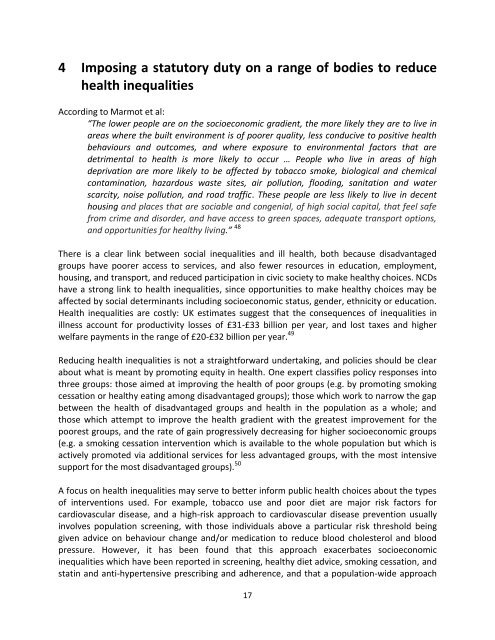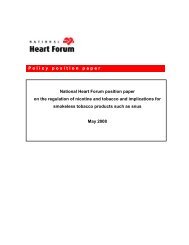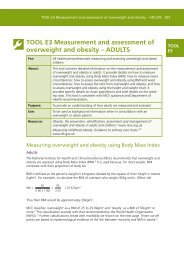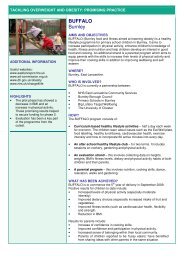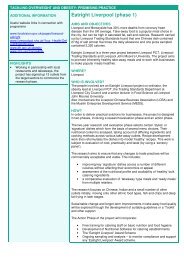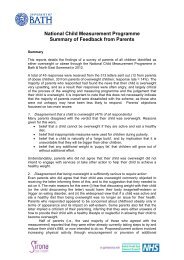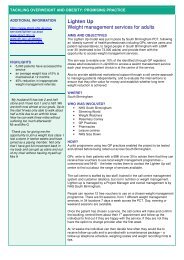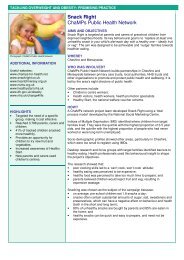Public Health Law and Non-communicable Diseases - UK Health Forum
Public Health Law and Non-communicable Diseases - UK Health Forum
Public Health Law and Non-communicable Diseases - UK Health Forum
You also want an ePaper? Increase the reach of your titles
YUMPU automatically turns print PDFs into web optimized ePapers that Google loves.
4 Imposing a statutory duty on a range of bodies to reduce<br />
health inequalities<br />
According to Marmot et al:<br />
“The lower people are on the socioeconomic gradient, the more likely they are to live in<br />
areas where the built environment is of poorer quality, less conducive to positive health<br />
behaviours <strong>and</strong> outcomes, <strong>and</strong> where exposure to environmental factors that are<br />
detrimental to health is more likely to occur … People who live in areas of high<br />
deprivation are more likely to be affected by tobacco smoke, biological <strong>and</strong> chemical<br />
contamination, hazardous waste sites, air pollution, flooding, sanitation <strong>and</strong> water<br />
scarcity, noise pollution, <strong>and</strong> road traffic. These people are less likely to live in decent<br />
housing <strong>and</strong> places that are sociable <strong>and</strong> congenial, of high social capital, that feel safe<br />
from crime <strong>and</strong> disorder, <strong>and</strong> have access to green spaces, adequate transport options,<br />
<strong>and</strong> opportunities for healthy living.” 48<br />
There is a clear link between social inequalities <strong>and</strong> ill health, both because disadvantaged<br />
groups have poorer access to services, <strong>and</strong> also fewer resources in education, employment,<br />
housing, <strong>and</strong> transport, <strong>and</strong> reduced participation in civic society to make healthy choices. NCDs<br />
have a strong link to health inequalities, since opportunities to make healthy choices may be<br />
affected by social determinants including socioeconomic status, gender, ethnicity or education.<br />
<strong>Health</strong> inequalities are costly: <strong>UK</strong> estimates suggest that the consequences of inequalities in<br />
illness account for productivity losses of £31-£33 billion per year, <strong>and</strong> lost taxes <strong>and</strong> higher<br />
welfare payments in the range of £20-£32 billion per year. 49<br />
Reducing health inequalities is not a straightforward undertaking, <strong>and</strong> policies should be clear<br />
about what is meant by promoting equity in health. One expert classifies policy responses into<br />
three groups: those aimed at improving the health of poor groups (e.g. by promoting smoking<br />
cessation or healthy eating among disadvantaged groups); those which work to narrow the gap<br />
between the health of disadvantaged groups <strong>and</strong> health in the population as a whole; <strong>and</strong><br />
those which attempt to improve the health gradient with the greatest improvement for the<br />
poorest groups, <strong>and</strong> the rate of gain progressively decreasing for higher socioeconomic groups<br />
(e.g. a smoking cessation intervention which is available to the whole population but which is<br />
actively promoted via additional services for less advantaged groups, with the most intensive<br />
support for the most disadvantaged groups). 50<br />
A focus on health inequalities may serve to better inform public health choices about the types<br />
of interventions used. For example, tobacco use <strong>and</strong> poor diet are major risk factors for<br />
cardiovascular disease, <strong>and</strong> a high-risk approach to cardiovascular disease prevention usually<br />
involves population screening, with those individuals above a particular risk threshold being<br />
given advice on behaviour change <strong>and</strong>/or medication to reduce blood cholesterol <strong>and</strong> blood<br />
pressure. However, it has been found that this approach exacerbates socioeconomic<br />
inequalities which have been reported in screening, healthy diet advice, smoking cessation, <strong>and</strong><br />
statin <strong>and</strong> anti-hypertensive prescribing <strong>and</strong> adherence, <strong>and</strong> that a population-wide approach<br />
17


